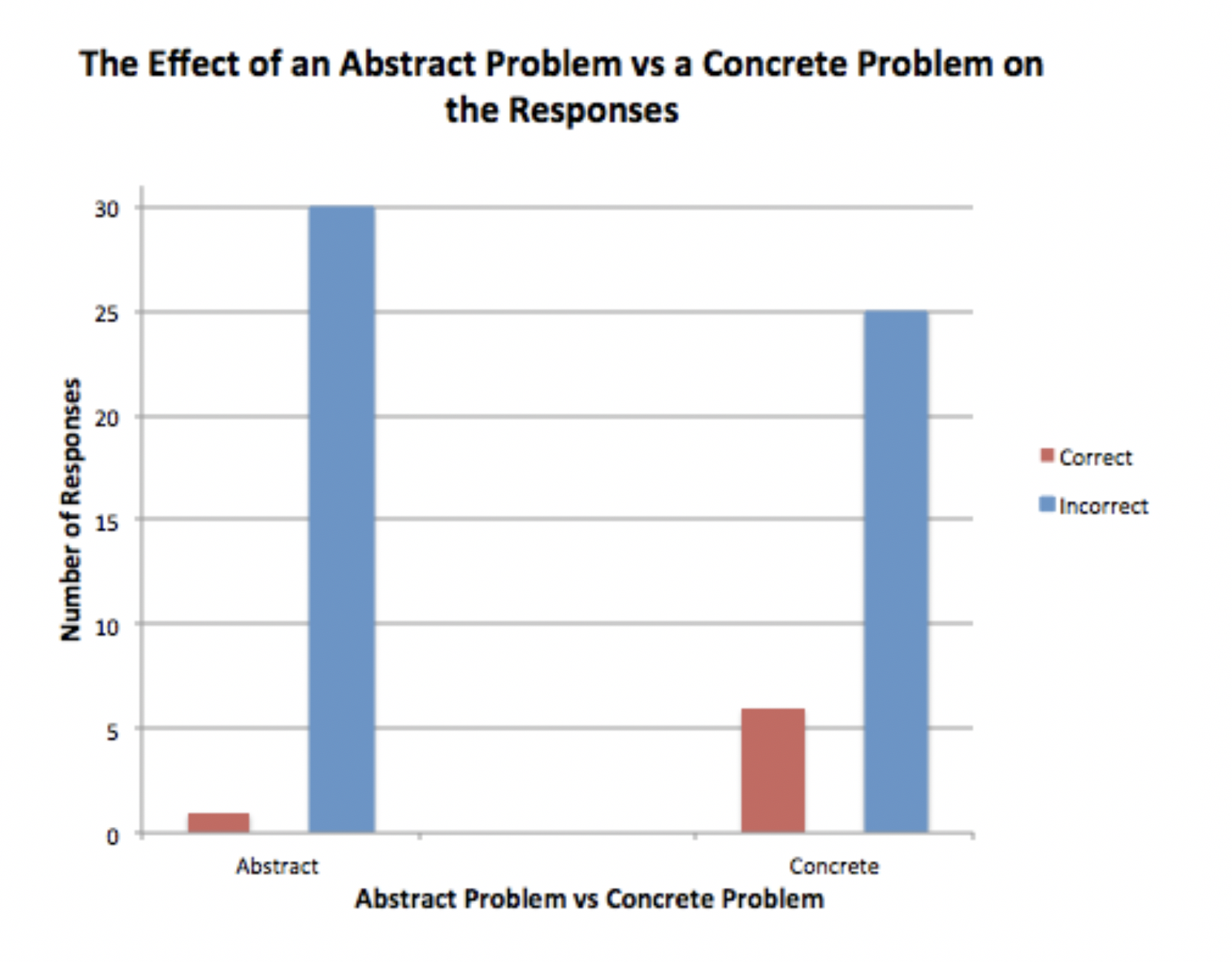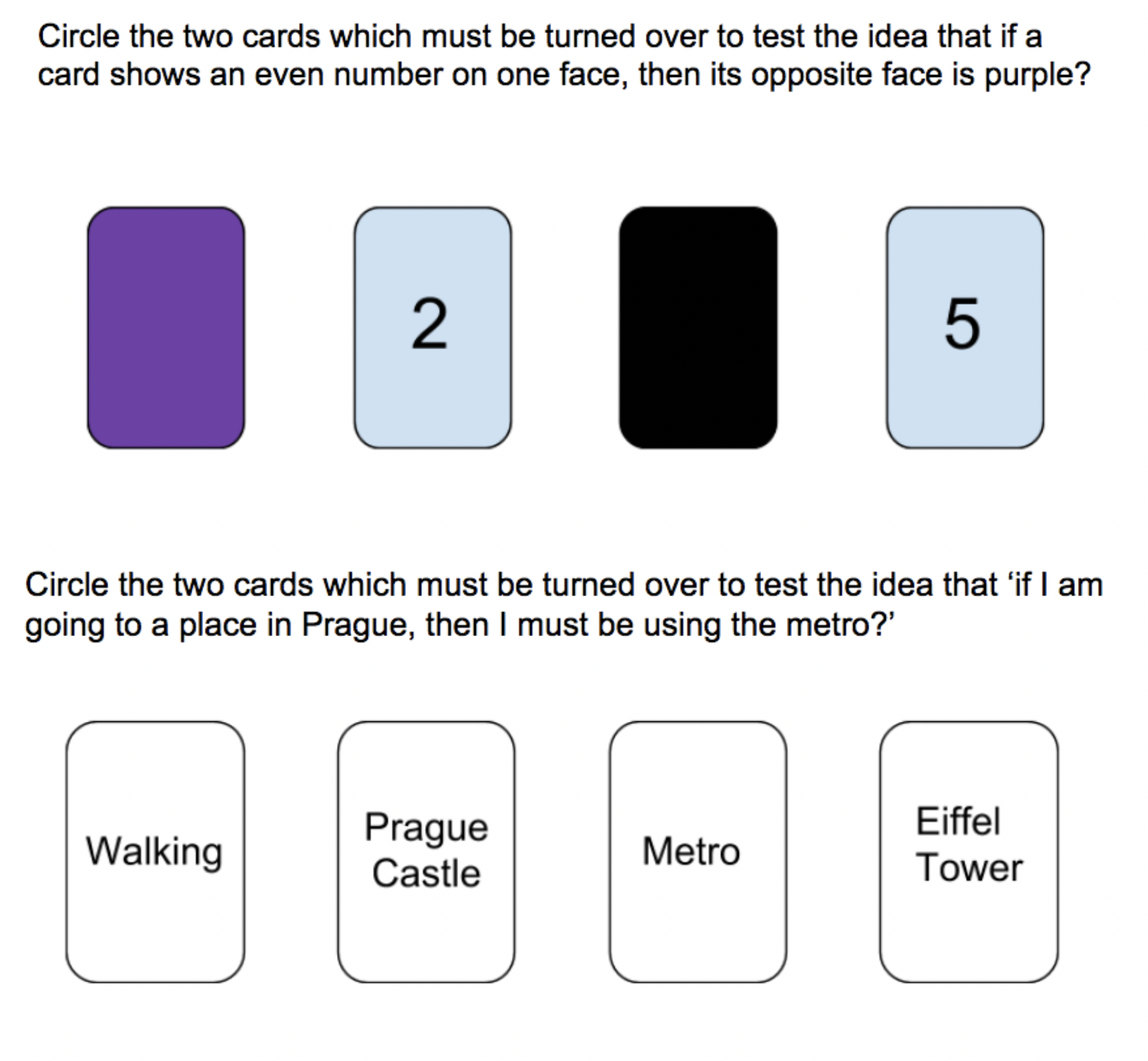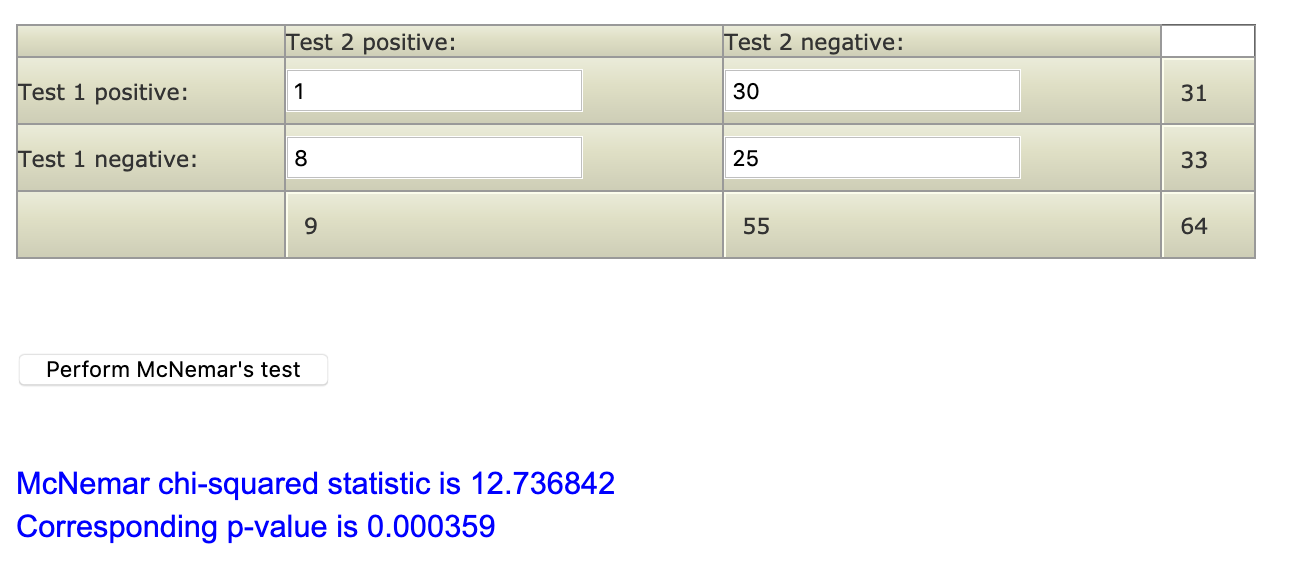IA marking: Sample 6
 The sample below is based on Wason and Shapiro's (1971) study of how concrete vs abstract words may affect one's ability to solve a problem.
The sample below is based on Wason and Shapiro's (1971) study of how concrete vs abstract words may affect one's ability to solve a problem.
The sample is based on a student's work, but is heavily edited and changes have been made to illustrate different facets of the IA.
The appendices do not include the letter of consent, materials, or the debriefing notes. The appendices do include the raw data and statistical calculations. Failure to include raw data or statistical calculations is penalized in the analysis.
Introduction
Cognitive psychologists concern themselves with how we come to know the things we know and we use our knowledge. They claim that mental representations guide our behaviors, meaning that how we process and organize our information determines how we behave. The Dual Process Model of thinking and decision-making has been applied to many areas in psychology including, persuasion, memory, and stereotyping (“Dual-Process Theories”). According to Stanovich and West (2000), there are two modes of thinking: System 1 and System 2. System 1 is a fast, intuitive, and spontaneous mode of thinking, while System 2 is a more rational, in-depth mode of thinking. It is believed that System 1 uses heuristics to draw conclusions, which makes it prone to errors as only one part of the problem is focused on and other information is ignored. System 2 is slow and takes more effort, which can result in more accurate conclusions. It is assumed that System 2 will be used when people are able and motivated to think carefully, but when this is not the case, a more superficial conclusion is made (“Dual-Process Theories”).
A study by Wason and Shapiro (1971) supports the Dual Process Model (Wason and Shapiro, p 67-69). The aim of the study was to investigate the effects of two different kinds of experiences on a misleading reasoning problem. This was done by using 32 first-year psychology students at University College London. They were each allocated to one of two groups: the concrete group or the abstract group. All participants were tested individually. The concrete group was presented with 16 cards, each with the name of a town on one side and a mode of transportation on the other side. Once they had inspected each card, four of them were then presented to the participants on the table. Two of the cards presented different destinations, “Manchester” and “Leeds”, and the remaining two were of modes of transportation, “car” and “train”. They were then asked to say which two cards would have to be turned over to test the rule given by the researcher: Every time I go to Manchester I travel by car. For the abstract group, the same procedure was followed, but instead, the cards had a letter of the alphabet on one side, and a number on the other, and the rule was: “Every card which has a D on one side has a 3 on the other side.” The researchers had predicted that the concrete group would perform better. This was seen with the results as 10 out of 16 of the participants in the concrete group answered correctly, while only 2 out of 16 of those in the abstract group answered correctly. This can be explained with System 1 and System 2 thinking as when the problem was more abstract, system 1 was not sufficient in answering correctly and was more prone to errors.
This study is a replication of Wason and Shapiro (1971) with a modification. We decided to use a repeated measures design to avoid participant variables and also allow for fewer participants needed. Using the findings in the original study, the aim of this study is to investigate the processing of concrete vs abstract decision-making tasks in a population of international high school students. This is worth studying because it is important to understand how the two systems of thinking interact with each other when addressing a problem. This study can help to explain why sometimes even when someone has knowledge about how to do something, given a different context, they won’t be able to.
Null hypothesis: There will be no significant difference in the responses given by international high school students of the two different cards to be chosen when presented with two different styles of problems (a concrete problem vs. an abstract problem).
Research hypothesis: International high school students will respond by choosing the correct two cards when presented with a concrete style of a problem rather than an abstract style of a problem.
The independent variable is the style of the problem (abstract or concrete); the dependent variable is the response to the problem (the choice of the two cards).
352 words
Exploration
This experiment used a repeated measures design. The independent variable is the type of problem (either abstract or concrete), where two cards have to be flipped over to test a rule; the dependent variable is whether the answer to the problem is correct or not. As different participants may have different levels of understanding of abstract and concrete problems, a repeated measures design was used to avoid these participant variables. While this comes with its own problems concerning order effects or practice effects, this was reduced through the use of counterbalancing, where half of the participants did condition 1 first and the other half did condition 2 first. The sampling technique was opportunity sampling as this was the most convenient. The sample was made up of two classes of first-year IB psychology students. This sample was chosen, as there would be a reduced level of participant variability as all students were fluent in English and able to understand the problem. There was a sample of 31 students, where 19 were females and 12 were males. In condition 1, where the abstract problem was first, there were 11 females and 6 males, and in condition 2, where the concrete problem was presented first, there were 8 females and 6 males.
We created a slip of paper for each participant where on one side was the abstract problem and on the other was the concrete problem (see appendix I). The rule for each of the problems was above an image of 4 different cards. The participants would be asked to circle two of the cards to test the rule. We presented the rules above the cards in hopes of reducing the variable of a participant simply not remembering the rule presented, thus circling random cards. All participants were given the same papers, at the same sizes. The rules we created were similar to the ones given in the original study, but the concrete rule was tweaked to be more related and understandable to the sample used. Instead of using ‘Manchester’ as a part of the rule, ‘Prague’ was used, ensuring that all participants in the sample were familiar with the city and its modes of transportation.
An online randomizer was used to randomly allocate the participants into what condition they would complete first. The participants were asked to sign a consent form (see appendix II). For each condition, a set of standardized directions was read to the participants (see appendix III). The same person, to control the same tone of voice, speed, and accent presented to the participants, as this could influence participants’ understanding, read these standardized directions to both groups. The participants were then given the slip of paper with the image of the 4 different cards and were given one minute to circle their two choices of cards. The one-minute was timed and used as a control for not giving any of the participants' advantages through more or less time. The participants were asked not to put their names on the paper, to keep maintain anonymity. Once both conditions were completed, the papers were collected. The participants were then debriefed once the results were available (see appendix IV).
692 words
Analysis
Table 1. The Frequency of Correct and Incorrect Responses
| Correct | Incorrect | Total | |
| Abstract | 1 | 30 | 31 |
| Concrete | 6 | 25 | 31 |
| Total | 7 | 55 | 62 |
Since the data collected was nominal, as it simply fell into either the correct or incorrect category, many descriptive statistics were not available. It can be seen, however, that the mode for both the abstract condition and the concrete condition was "incorrect." However, the concrete condition did result in more correct responses, regardless of which condition was presented to the participants first. When the concrete condition was presented first, 11% of the participants responded correctly, compared to 7.7% when the abstract condition was presented first (see appendix V). The concrete condition resulted in 19.35% correct responses, compared to only 3.23% in the abstract condition. This seems to indicate that concrete problems may, in fact, lead to more correct responses.

Since our data was nominal and our design was repeated measures, a Mcnemar chi-square test was used (see appendix VI) was used to determine whether the difference in the frequency of correct responses was significant. The test showed that the data was significant at p ≤ 0.001, meaning the null hypothesis can be rejected, and the research hypothesis accepted. It seems that the way in which a problem is presented (abstract or concrete) can play a significant role in the ability of international high school students to solve the problem.
192 words
Evaluation
We were able to support the findings of Wason and Shapiro (1971) and the hypothesis that the way a problem is presented (abstract vs. concrete) influences the person’s ability to get to the correct response. However, the original researchers found a higher difference between the two groups than we did. In the original study, almost 14.3% of the participants were able to respond correctly when presented with an abstract problem compared to 62.5% when presented with a concrete problem. In our study, these percentages were 3.23% and 19.35% respectively. The difference could be due to our participants being international students, presenting varying levels of English proficiency.
When we look at the slight difference between the percentages of correct responses, it can be deduced that when the participants were faced with an abstract problem, System 1 thinking was not adequate to solve the problem. Matching bias was most likely used, meaning that the wording of the question (‘purple’ and ‘even number’) overly influenced the participants (Crane). This supports the Dual Process Model as when the cognitive load was higher, and information had to be processed fast to make a quick decision, System 1 kicked in and was prone to errors.
A strength of this study’s design was the fact that it allowed for both groups to complete both conditions, which would, in theory, decrease participant variability. This ensured that even if one group had more participants used to abstract-style problems, this would not affect the results. A problem with this, however, is order effect, as the participants could improve in their ability to answer such questions through practice; however, this is not what we saw in our results. Even though we counterbalanced the two conditions by presenting them to the two different groups in a different order, the condition presented first could still affect the second. This could be modified in the future by creating a filler task between the two conditions to get the participants' minds off the questions.
A strength of the sample was the participants all being between 16 and 18-years-old. If a younger sample were used, they may not have understood the directions or questions presented to them. However, the participants were international students, meaning they could have different levels of English fluency which could have hindered their ability to grasp the problem presented. As the study was done in an international school, a future modification could be to only use participants that had English as their mother tongue or were in an advanced English class, but this would still not eliminate the possibility of English levels differing. Another possibility would be to give the participants an English comprehension task before the study and only use those that showed high English comprehension. Another limitation with the sample was the problem of the participants being disinterested in the task presented as the study was conducted before an in-class assessment. With the sample used, the results cannot be generalized because of the limited age group. Only high school students were used, meaning the participants could be more or less able to complete abstract and concrete tasks such as the ones used. Also, because different cultures were included, there may have been more variance in the way of thinking compared to only one culture.
A strength with the procedure was the implementation of counterbalancing, as mentioned before, to limit order effect. A limitation with the procedure was that the participants could have actually started to read the question and hypothetically start thinking about how to answer the question before we read it aloud and started the timer, as the rest of the papers were being handed out. A modification for this would be to include in the directions before the paper was handed out, that the participants were not allowed to start or read the paper until they were told to do so.
From our study, we can conclude that in a sample of international high school students, the style of a problem (abstract and concrete) affects the chosen responses, with concrete tasks resulting in more correct responses.
678 words
Total word count: 1914 words
Works cited
Crane, John. "IB Psychology." InThinking, www.student.thinkib.net/psychology/page/22835/new-curriculum-textbook. Accessed 12 Oct. 2018.
"Dual-Process Theories." IResearchNet, psychology.iresearchnet.com/social-psychology/social-psychology-theories/dual-process-theories/. Accessed 12 Oct. 2018.
Stanovich, K. E., & West, R. F. (2000). Individual Differences in Reasoning: Implications for the Rationality Debate? Heuristics and Biases, 421-440. doi:10.1017/cbo9780511808098.026
Wason, P.C., and Diana Shapiro. (1971) "Natural and Contrived Experience in a Reasoning Problem." Quarterly Journal of Experimental Psychology, vol. 23, 1971, pp.67-69, citeseerx.ist.psu.edu/viewdoc/
Appendix i. Materials

Appendix ii. Raw data
Table 1. Number of correct responses in counterbalanced conditions
| Correct | Incorrect | |
| Abstract presented first | 1 | 12 |
| Concrete presented second | 4 | 9 |
| Abstracted presented second | 0 | 18 |
| Concrete presented first | 2 | 16 |
| Total correct: abstract condition | 1 | 30 |
| Total correct: concrete condition | 6 | 25 |
Appendix iii. Calculation of the McNemar chi squared test

Assessment
Introduction (max 6 marks)
The aim of the investigation is stated and its relevance is identified but not explained (4 marks) The independent and dependent variables are correctly stated in the null or research hypotheses. (6 marks). The theory or model upon which the student’s investigation is based is described and the link to the student’s investigation is explained (5 marks).
Total: 5 marks
Exploration (max 4 marks)
The characteristics of the participants are described, but in limited detail (2 marks). Controlled variables are described, but the reasons for the controls are not explained (2 marks); The research design is described and explained, but could be more clearly explained (3 marks). The sampling technique is explained (4 marks). The choice of materials is explained (4 marks).
Total: 3 marks
Analysis (max 6 marks)
Descriptive and inferential statistics are appropriately and accurately applied (6 marks). The graph is correctly presented and addresses the hypothesis (6 marks). The statistical findings are interpreted with regard to the data and linked to the hypothesis, but could be more developed (5 marks).
Total: 6 marks
Evaluation (max 6 marks)
The findings of the student’s investigation are discussed with reference to the background theory or model. However, the reason why System 1 thinking was used is identified, but not well explained. What is meant by the argument that the participants had a higher cognitive load? (5 marks); Strengths and limitations of the design, sample, and procedure are stated and explained and relevant to the investigation (5 marks); Modifications are described and well linked to the limitations of the study (6 marks).
Total: 5 marks
Total marks
Total: 19 marks
IB 7

 IB Docs (2) Team
IB Docs (2) Team
